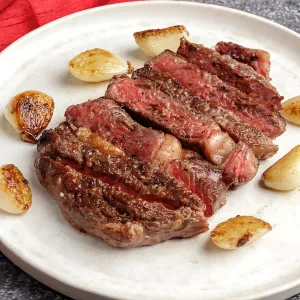
Ribeye Steak Thinly Sliced Recipe
When I first tried making thinly sliced ribeye steak, I was blown away by how quickly it came together and the burst of flavors in every bite!
Ingredients
- 1 ribeye steak less than 1 inch thick, at room temperature
- ½ teaspoon vegetable oil
- 2 tablespoons unsalted butter
- 8-10 garlic cloves optional
- 2 sprigs fresh rosemary
- 3-4 sprigs fresh thyme
- Coarse salt to taste
- Coarsely ground black pepper to taste (optional)
Instructions
- Before you start cooking, allow the steak to come to room temperature. This step ensures the meat cooks evenly. Dab the steak on both sides with a paper towel to remove excess moisture. Sprinkle coarse salt generously, and, if you like, add a little black pepper.
- Place your cast-iron skillet over high heat and allow it to get very hot. Add a small amount of oil and swirl it around to coat the pan. You’ll know it’s ready when you see a faint shimmer in the oil.
- Carefully place the steak in the skillet. Sear one side for about 2 minutes, then flip it and do the same for the other side. Continue flipping every 1-2 minutes to create a crust while avoiding overcooking the inside. After the third flip, reduce the heat to medium.
- Toss butter, garlic cloves, rosemary, and thyme into the pan. As the butter melts, tilt the skillet slightly to pool the melted butter. Use a spoon to baste the steak repeatedly with the butter mixture. This step infuses the meat with bold flavors and keeps it moist.
- Insert a meat thermometer into the thickest part of the steak. For rare: 115-120°F, medium-rare: 120-125°F, medium: 130-135°F. Remember, the steak will continue to cook slightly as it rests, so remove it from heat a few degrees before your target temperature.
- Transfer the steak to a clean cutting board and loosely cover it with foil. Allow it to rest for about 5 minutes. This step lets the juices redistribute, making the steak juicier.
- Slice the steak thinly against the grain to maximize tenderness. Serve it immediately with the soft garlic, a drizzle of the herb-infused butter, and your favorite sides.
Notes
- Bring the steak to room temperature before cooking for even doneness.
- Dry the steak thoroughly to ensure a crispy crust when seared.
- Preheat the skillet well; the hotter, the better for getting that golden crust.
- Use an instant-read thermometer to avoid overcooking or undercooking.
- Don’t skip the resting stage! It locks in all those delicious juices.
- Flip often while searing to cook the steak more evenly.